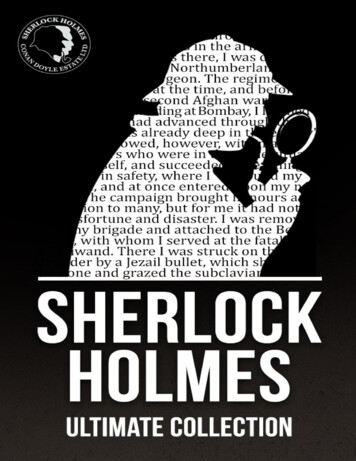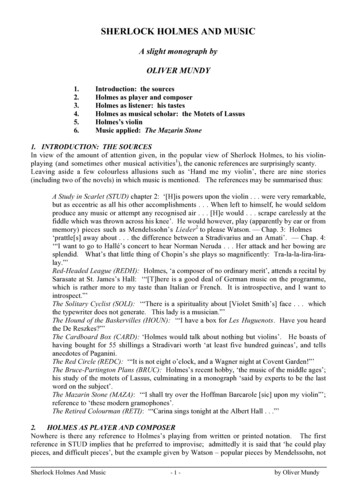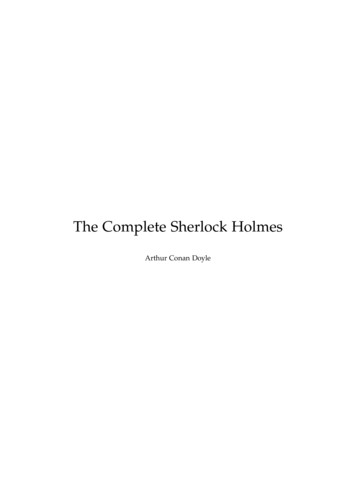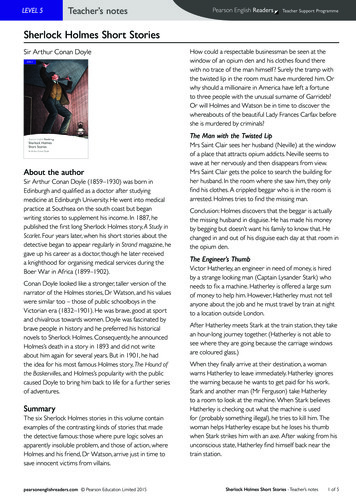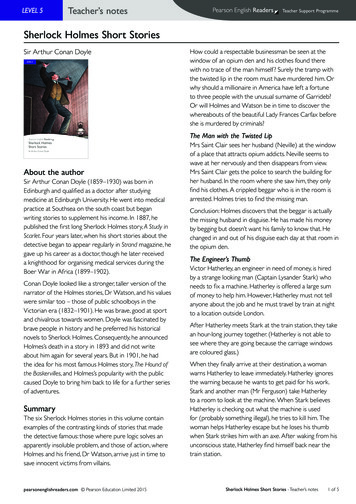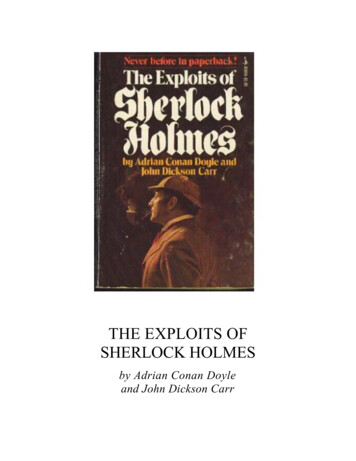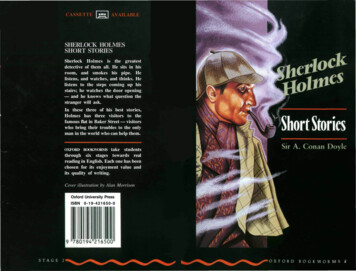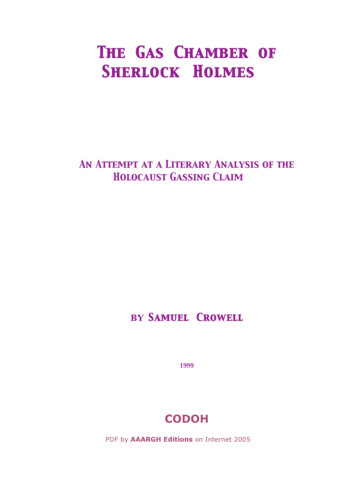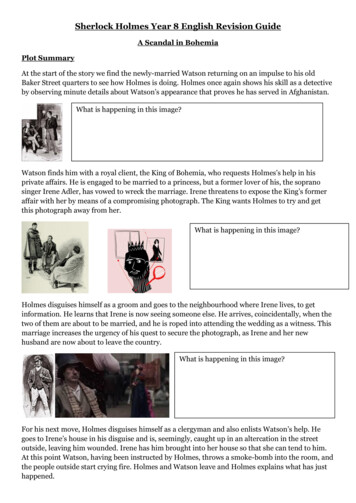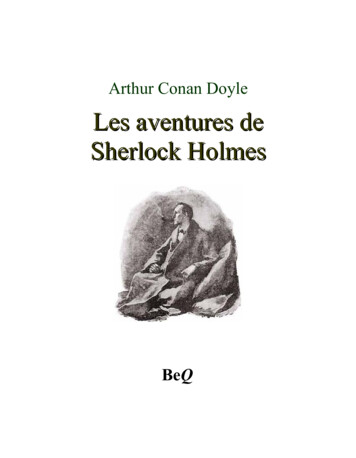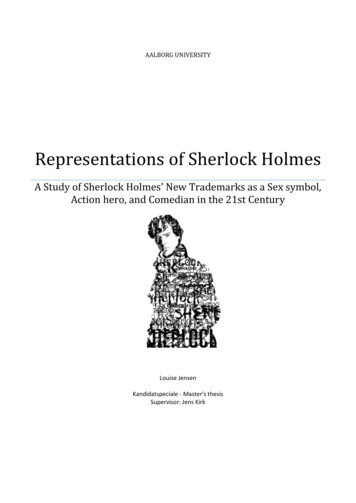
Transcription
AALBORG UNIVERSITYRepresentations of Sherlock HolmesA Study of Sherlock Holmes' New Trademarks as a Sex symbol,Action hero, and Comedian in the 21st CenturyLouise JensenKandidatspeciale - Master's thesisSupervisor: Jens Kirk
Louise Jensen10th semesterSherlock HolmesMaster's thesisAalborg University2/10-2014Table of contents1. Introduction.41.1 Sherlock Holmes' image.41.2 Film and TV-series adaptations.61.3 Problem statement.81.4 Structure.82. Methodology.102.1 Comparing two different media.102.1.1 Limitations on screen.102.1.2 Limitations in literature.112.2 Selected theories.122.3 Selected film and TV adaptations.143. Theory.163.1 The theory of adaptation.163.2 Culture and representation.173.3 Conceptualising symbols and trademarks.183.4 The theory of representation.183.5 Semiotics.203.6 Denotation and connotation.213.7 Sign.213.8 Partial conclusion.234. Analysis.244.1 Sherlock Holmes - the sex symbol.244.1.1 Holmes and the man in his life.254.1.2 Sherlock and his women.344.1.3 The archenemy Professor Moriarty.394.1.4 Partial conclusion.42Page 2 of 59
Louise Jensen10th semesterSherlock HolmesMaster's thesisAalborg University2/10-20144.2 Sherlock Holmes, the action hero.424.2.1 The universal character.424.2.2 Power of deduction and observations.444.2.3 Partial conclusion.474.3 The great comedian, Mr. Holmes.474.3.1 The intelligent and witty Holmes.484.3.2 Partial conclusion.505. Conclusion.515.1 The sexual identity.515.2 The action hero.535.3 The comedian.545.4 Further research questions.556. Bibliography.576.1 Emperical data.576.2 Books and articles.576.3 Internet.586.4 Front-page picture.596.5 Pictures.59Page 3 of 59
Louise Jensen10th semesterSherlock HolmesMaster's thesisAalborg University2/10-20141. IntroductionThe fascinating and famous story A Study in Scarlet is written by Sir Arthur Conan Doyle in 1887. Thisdetective novel was the first story to feature the character of Sherlock Holmes. The novel is based on thecompanionship between the world's only consulting detective, Sherlock Holmes, and the veteran wardoctor referred to as Dr. John Hamish Watson (Porter, 2012, p. 5). At first the story attracted little publicattention and interest; however, four years later it became an immense success and this ensured thatConan Doyle wrote a series of sequels (ibid.). In fact, Conan Doyle wrote four novels and 56 short storiesabout the two main characters (ibid., p. 145).The deerstalker, the magnifying glass, and thecurved pipe are signs and trademarks which make thecharacter of Sherlock Holmes recognisable for audiencesaround the world. The popularity is not decreased despitethe fact that some of the stories are written over 100years ago. The original four novels and fifty six stories aregreat inspirations for adaptations in many differentKiwicraig, 2014genres such as comics, theatre, radio programmes, videogames, TV-series, and films (ibid., p. 6). In the TV-series and film adaptations every actor, screen writer, anddirector have their own ideas as to how the detective and doctor should be portrayed. Even though severaltrademarks reappear in the adaptations, it is remarkable that new trademarks surface. Sherlock Holmes is asex symbol, an action hero, and a comedian in the 21st century. The different ways in which Holmes andWatson are portrayed relate to image, which the following section presents.1.1 Sherlock Holmes' imageThe character of Sherlock Holmes is believed to have been inspired from Conan Doyle's own professor, Dr.Joseph Bell. Dr. Bell could diagnose patients' diseases based on minor observations (Lycett, 2008, p. 190).This must have intrigued and fascinated Conan Doyle when he created Sherlock Holmes as one of hisfictitious characters. As mentioned, Holmes has been portrayed numerous times since A Study in Scarletwas published and the character continues to be renewed and updated for new audiences. Therefore,Holmes is one of the most portrayed fictive characters in stage and cinematic productions (Porter, 2012, p.6).Page 4 of 59
Louise Jensen10th semesterSherlock HolmesMaster's thesisAalborg University2/10-2014Despite the fact that Conan Doyle never gave a clear and thorough description of Holmes'appearance, Sidney Paget, a British illustrator, still managed to create illustrations of Holmes which helpedcreate the image of Holmes as audiences know him today. Paget illustrated the publications in The StrandMagazine. The assignment of illustrating Sherlock Holmes was supposed to be handed to his youngerbrother, but by accident it went to Sidney Paget (Porter, 2012, p. 25). Some believe that Paget used WalterPaget, his younger brother, as a model for Sherlock Holmes, while others claim that Paget's illustrations ofHolmes were inspired by a description Dr. Watson offers in A Study in Scarlet (1887). Hence, Dr. Watsondescribes Holmes:His very person and appearance were such as to strike the attention of the most casualobserver. In height he was rather over six feet, and so excessive lean that he seemed to beconsiderably taller. His eyes were sharp and piercing, save during those intervals of torpor towhich I have alluded; and his thin, hawk-like nose gave his whole expression an air ofalertness and decision. His thin, too, had the prominence and squareness which mark theman of determination. His hands were invariably blotted with ink and stained with chemicals,yet he was possessed of extraordinary delicacy of touch, as I frequently had occasion toobserve when I watched him manipulating his fragile philosophical instruments.(Conan Doyle, 1992, p. 14-5)John Watson's description of Holmes contains none of the trademarks which make Holmes and evenWatson recognisable all over the world. It is believed that Paget, through his illustrations, gave Holmessome of the recognisable trademarks such as the high collared coat and the deerstalker (Porter, 2012, p.25). These and many other trademarks are often included when actors and directors create TV-series orfilm adaptations and representations of Sherlock Holmes.When adapting a fictional story, it is sometimes necessary to reinventand renew the character; however, most of the adaptations stay trueto the idea that Holmes is situated in Victorian London. Nonetheless,in the recent adaptations the plot unfolds in modern London or NewYork. The plot still contains the original Conan Doyle-storyline, but it ismodernised to a current time scale. This also means that the fictitiouscharacter of Holmes develops and adds some new trademarks to hispersona.This now means that he is a 21st century sex symbol, comedian,and action hero. When taking this into consideration, this thesis isPage 5 of 59Toronto Public Library
Louise Jensen10th semesterSherlock HolmesMaster's thesisAalborg University2/10-2014interested in examining why these changes are possible. Moreover, Steven Moffat, the creator of Sherlock(2010-) stated before the premiere of his television series thatConan Doyle's stories were never about frock coats and gas light; they're about brilliantdetection, dreadful villains and blood-curdling crimes- and frankly, to hell with crinoline.Other detectives have cases, Sherlock Holmes has adventures, and that's what matters.(Block, 2010)Based on this notion, it is noticeable that the recent adaptations still contain detective work, villains, andthrilling crimes which suggest that the stories of Sherlock Holmes still feature the original trademarksalthough they take place in a more current and modern time frame.1.2 Film and TV-series adaptationsThe first film adaptation of Sherlock Holmes was an American production named Sherlock Holmes Baffled(Barnes, 2011, p. 216). It was a black and white edition from 1900 and it lasts about 35 seconds (ibid.). Itdepicts Holmes facing a villain who keeps disappearing. The film paved the way for succeeding actors tomake their own representations of Sherlock Holmes. Representations of Holmes have been made by actorssuch as Viggo Larsen, William Gillette, Clive Brook, Basil Rathbone, Peter Cushing, Jeremy Brett, RobertDowney Jr., Benedict Cumberbatch, and Jonny Lee Miller (ibid., p. 316-29). The different representationsincluded are accounted for in the following part of this introduction. Furthermore, the reasons for choosingthem are elaborated on in chapter two: Methodology.The recent adaptations create a newfound love for Sherlock Holmes. Both pre-existing and newer fanscome together and embrace the new sides of the detective. One of the new sides experienced in relation toSherlock Holmes is found in Guy Ritchie's two adaptations; Sherlock Holmes from 2009 and SherlockHolmes: A Game of Shadows from 2011. In the adaptations by Ritchie, Holmes turns into an action herowho is not afraid of going into combat. At the same time, the character of Holmes is interpreted ascharming, bohemian, scruffy, and unhygienic in the Robert Downey Jr.'s representation. The two films areboth set in Victorian London. The first film is based on Holmes and Watson fighting against LordBlackwood's black magic and the second film focuses on Holmes' battle with Professor Moriarty.Page 6 of 59
Louise Jensen10th semesterSherlock HolmesMaster's thesisAalborg University2/10-2014The basis of the two adaptations is the special relationship between Sherlock Holmes and JohnWatson. The word 'bromance' is used frequently in connection to the films. According to Gyldendals RødeOrdbøger, 'bromance' is a slang word used to describe the intense and nonsexual relationship between twomen (Gyldendal, 2014). Robert Downey Jr. added further speculations about the relationship and bromanceaspect during the promotion of the film in 2009. He stated that Holmes and Watson are 'two men whohappen to be roommates, wrestle a lot and share a bed. [.]' (Carroll, 2009).The concept of bromance is also present in other adaptations, one of them being the British BBCproduction Sherlock which started airing in 2010. It features Benedict Cumberbatch and Martin Freeman asSherlock Holmes and John Watson and it is created by Mark Gatiss and Steven Moffat. The plot of theepisodes is almost identical to Sir Arthur Conan Doyle's stories yet modernised a bit. Holmes is an asexualman with a clear substance abuse who lives in the 21st century London while Watson is a veteran doctorwho has returned from serving in Afghanistan. The TV-series, just as Ritchie's adaptation, focuses a lot onthe relationship between the two main male characters. The creators and the actors made Holmes into acomical figure that lacks social skills and is viewed by a lot of people as a homosexual man. This createshumorous scenes which the audiences are able to enjoy.Sherlock (2010-) frequently touches upon Holmes' sexuality and this is also done in the recent Americanadaptation. Robert Doherty's CBS TV-series Elementary (2012-) completely renews the stories of SherlockHolmes. The television series from 2012 stars Jonny Lee Miller as recovering drug addict Sherlock Holmesand Lucy Liu as Joan Watson, his sober companion. The series is set in 21 st century New York and showsHolmes in the time after his rehab. The new side to Sherlock Holmes features him is a sex symbol with aclear sexual orientation. It is often indicated that Holmes has sex with women, but he does not sleep withthe female Watson. Doherty wants to create a TV-series that does not contain a love affair with the twolead characters although it is often indicated that the pair could be together (Roberts, 2012). Dohertyremains true to his own statement that he wants the relationship to be professional and let them focus onsolving crimes in New York (ibid.).There is no doubt that Sherlock Holmes and John Hamish Watson have undergone a huge transformationsince their birth in the 19th century. Some trademarks survive while others are added in connection to therepresentations and adaptations. A few trademarks are modernised in order to fit within a modern timeframe. This concludes the introduction of this master's thesis and as Sherlock Holmes would have uttered:Page 7 of 59
Louise Jensen10th semesterSherlock HolmesMaster's thesisAalborg University2/10-2014'"Come, Watson, come!" he cried. "The game is afoot."'(Conan Doyle, 1992, p. 711)1.3 Problem statementThis thesis is based around the new trademarks of Sherlock Holmes. The recent adaptations introduce newsides to the character than the ones from Conan Doyle's stories. Therefore, three new trademarks areexamined and put in the analysis. The three chosen trademarks are:- The sexual identity of Sherlock Holmes.- Sherlock Holmes as an action hero.- The funny and humorous detective.When viewing the more recent film and TV-adaptations, how is it possible to view Sir Arthur Conan Doyle'sliterary works with the character of Sherlock Holmes as a cultural and universal text? It is obvious to seethat Sir Arthur Conan Doyle's character receives new trademarks in the 21st century. Therefore, this thesiswishes to illustrate and analyse the changes experienced in connection to Sherlock Holmes and thusexamine why these changes are possible.In order to do it, the following sub-questions will be analysed with the aim of answering these researchquestion:- How is Sherlock Holmes' sexuality represented?- How does Sherlock Holmes fulfil being categorised as an action-hero?- What makes it possible for Sherlock Holmes to be a comedian on screen?- Why do audiences need a consulting detective in the 21st century?1.4 StructureThe following structure occurs in this thesis: Methodology: In this chapter the theories and adaptations are accounted for. The reasons forincorporating these theories and adaptations are also included in this chapter. Moreover, thePage 8 of 59
Louise Jensen10th semesterSherlock HolmesMaster's thesisAalborg University2/10-2014theories have received some critique which is illustrated in this section. This helps to demonstratethe thoughts on why the theories are included. The chapter of methodology further contains asection on the difficulties when analysing two different media. This chapter closes with a section onthe limitations of this thesis and how this influences the structure. Theory: This chapter contains sections to conceptualise the theories for this thesis. The theorieswhich are used in the analysis are the theory of adaptation and Stuart Hall's view onrepresentation. Furthermore, culture, trademarks, and signs are important concepts which areelaborated. In connection to Hall's theory, Ferdinand De Saussure's theory of semiotics and signs aswell as Roland Barthes' thoughts on denotation and connotation are chosen. Analysis: In the analysis the new trademarks of Sherlock Holmes are highlighted. The character ofSherlock Holmes is recognisable to the world due to his trademarks such as the deerstalker, pipe,trench coat, and the relationship with Watson. He is reinvented in newer adaptations with newtrademarks such as being a sex symbol, an action hero, and a comedian. These trademarks do notentirely correspond with Sir Arthur Conan Doyle's original stories.The analysis contains several close-readings from a number of adaptations andrepresentations. These include Guy Ritchie's two blockbusters Sherlock Holmes (2009) and SherlockHolmes: A Game of Shadows (2011), Steven Moffat's and Mark Gatiss' Sherlock (2010-), and lastlyRobert Doherty's Elementary (2012-). Conclusion: In this chapter, this thesis’ conclusive findings are revealed and the entire thesis isconcluded on and finally, future research questions are presented.Page 9 of 59
Louise Jensen10th semesterSherlock HolmesMaster's thesisAalborg University2/10-20142. MethodologyIn this methodological chapter, the theories, films, and TV adaptations incorporated are presented. Thedifficulties when comparing two different media are explained and why it is essential to compare differentadaptations and representations in order to see the changes that the character of Sherlock Holmes hasundergone. The adaptations are compared to Sir Arthur Conan Doyle's original literary stories and theanalysis uses theories which show the new trademarks that are added to Sherlock Holmes.2.1 Comparing two different mediaThis thesis is based on a comparative analysis of two different media, literature and film. It is natural whenworking with two different media that obstacles occur since the media are different from each other. Oneexample deals with characterisation which is done by either telling or showing the reader or viewer.Characterising in literature is done by telling since the visual aspect is lacking. A character is thereforedescribed according to either appearance or behaviour. A character's thoughts, state of mind, and minorcharacter's thoughts can also be included when doing a characterisation. In a film or TV-series,characterisation is easily done by showing actions, narratives, body language, and facial expressions. It iseasy for an actor or director to show a character's visual trademarks.2.1.1 Limitations on screenThis section explains the limitations in films since film and TV-series often have a time frame which must bekept. It is important to mention in relation to this thesis that the film media do not allow the viewers toimagine their own versions of the character because an actor is representing the character. The narrativesoften disappear and directors use other methods to tell their stories. Examples of these methods arementioned in the paragraph above. In relation to the stories of Sherlock Holmes, the narratives of JohnWatson have disappeared. Guy Ritchie, Steven Moffat, Mark Gatiss, and Robert Doherty are the directorsand creators of the films and TV-series used in the analytical chapter. The above-mentioned directors haveall chosen to leave out Watson's narratives and the stories are told by either actions or through the maincharacter Sherlock Holmes.Page 10 of 59
Louise Jensen10th semesterSherlock HolmesMaster's thesisAalborg University2/10-20142.1.2 Limitations in literatureLiterature often lacks the visual aspect, but this can besomewhat added by illustrations. Different types ofillustrations are included in the stories of Sherlock Holmesas The Strand Magazine used illustrations by Sidney Paget.He created some of Sherlock Holmes' existing trademarksthough Sir Arthur Conan Doyle never incorporated these inhis stories. An example is the deerstalker which ConanDoyle never described in his stories (Porter, 2012, p. 25).Conan Doyle wrote that Holmes wears a 'close-fitting clothcap' (Conan Doyle, 1992, p. 159) that Paget through hisillustrations turned into one of the most recognisableStock, 2012synonyms of the consulting detective.One of the main themes in Stuart Hall's theory of representation deals with social interactions that help toaccept the cultural meanings to each word. Written words have meaning attached to them through socialinteractions in cultures. Stuart Hall coins representation asthe production of the meaning of the concepts in our minds through language. It is the linkbetween concepts and language which enables us to refer to either the "real" world ofobjects, people or events, or indeed to imaginary worlds of fictional objects, people andevents.(Hall, 1997, p. 17)One example is the written word CAR which needs a cultural and mental understanding. The trademarkssuch as the deerstalker, pipe, and magnifying glass are culturally connected to Sherlock Holmes. If one seesthe image of the deerstalker, one would automatically connect it to the character of Holmes. Consequently,the deerstalker is incorporated in many of the film and TV-series adaptations of the stories.Despite these mentioned obstacles, the two media, literature and film, are often subjects for adaptationsand representations as the ones of the consulting detective stories. The next section illustrates why theincorporated theories are chosen for this thesis.Page 11 of 59
Louise Jensen10th semesterSherlock HolmesMaster's thesisAalborg University2/10-20142.2 Selected theoriesThe theories included in this master's thesis are coined by Stuart Hall, Ferdinand De Saussure, and RolandBarthes. Their theories are chosen because they view images as a form of language. A language carriesmeaning which is shaped through social interaction. The image of a man wearing a deerstalker while usinga magnifying glass and smoking a pipe carries connotations and meanings. It means that most peoplerecognise the image of the consulting detective based on these trademarks. Sherlock Holmes is an iconicimage in British culture and he is one of the most recognisable images in literature and film.The cultural theorist Stuart Hall has developed a theory of representation. It is selected for this thesis sinceactors and directors make representations in the form of film or TV adaptations. They create their ownversions of Sherlock Holmes. According to Stuart Hall a representation is when 'using language to saysomething meaningful about, or to represent, the world meaningfully, to other people' (Hall, 1997, p. 15).Actors in these adaptations represent Holmes and are therefore conveying something meaningful aboutConan Doyle's original character.The late Stuart Hall is a natural choice since his points of view shaped cultural studies. Hall's threeapproaches of representation are elaborated on in the analytical chapter of this thesis. Especially oneapproach stands out because it deals with representation as a part of shaping meanings within a culture.This approach is named the constructionist approach of representation. The public shape meanings ofSherlock Holmes both within and across cultures.Critics argue that Stuart Hall's approaches of representation are too narrow and lack an important focusupon knowledge and power relations (Hall, 1997, p. 27). As Hall states:[.] representation was understood on the basis of the way words functioned as signs withinlanguage. But [.] meaning often depends on larger units of analysis - narratives, statements,groups of images, whole discourses which operate across a variety of texts [.](ibid., p. 42)In this quote, Hall demonstrates that representation previously functioned only as words in a language. Thewords are understood as signs that are read and translated into meaning by the viewers. However, wordsare not sufficient enough and other principles are taken into account. Representation is concerned withsocial interactions and how knowledge is created and shared within these interactions. Meanings arecreated through interactions and help to create an image, e.g. the image of Sherlock Holmes based on histrademarks. This image is translated across cultures without using language and words.Page 12 of 59
Louise Jensen10th semesterSherlock HolmesMaster's thesisAalborg University2/10-2014Secondly, Ferdinand De Saussure's theory regarding semiotics and signs is applied in this thesis. Semioticsallows images to be read as a language across cultures. Each culture has their own meaning andunderstanding of an object or image. Some of the meanings are shared by several cultures, just as theimage of Sherlock Holmes as explained in the introduction.In the book Representation: Cultural representations and signifying practices (1997), Stuart Hallincludes a chapter on the critique of Saussure's theory. Some of the criticism is based on the notion thatSaussure does not pay enough attention to the relations between the signifier and the signified. This couldbe used to refer to objects 'in the "real" world' as Hall states (Hall, 1997, p. 34). Hall explains that a wordrefers to meanings and one example is BOOK. This word can refer to several different books or even aspecific and particular one (ibid.). Furthermore, Ferdinand De Saussure tends to focus on formal languageusage. Language changes over time and therefore it cannot be placed within a closed system. The formaland the informal language usage can change, but they both create meanings (Hall, 1997, p. 35).The critic and semiotician Roland Barthes is the third theorist to be included in this thesis. He furtherdevelops Saussure's theory on semiotics as Barthes adds and incorporates concepts such as connotationsand denotations. These concepts are attached in order to pay attention to the person who is reading andinterpreting the image. It is important to incorporate the person who is interpreting an image whenworking with such an iconic figure as Sherlock Holmes. People around the world have different personalconventions about the character and these are useful in order to see how Holmes's trademarks havedeveloped. However, one must keep in mind that Barthes' theory was published in 1957 and it is thereforemore than 50 years old (egs.edu). Still, the concepts of denotation and connation are being used inresearch around the world.There has been a selection between theorists due to the page limitations. Michel Foucault is one of therejected theorists. Stuart Hall is fascinated with Foucault and is influenced by his ideas. Foucault's view onrepresentation is 'concerned with the production of knowledge and meaning through discourse' (Hall,1997, p. 51). Foucault believes that seeing the discourse in its historical framework is important since theknowledge is bound in explicit contexts. Critics agree that Foucault tends to be too involved with thediscourse and not the material (ibid.). Furthermore, he focuses a lot on the bond between power andknowledge in society and on how this is used by institutions to control societies (Hall, 1997, p. 47). Though,it would have been interesting to inc
thrilling crimes which suggest that the stories of Sherlock Holmes still feature the original trademarks although they take place in a more current and modern time frame. 1.2 Film and TV-series adaptations The first film adaptation of Sherlock Holmes was an American production named
